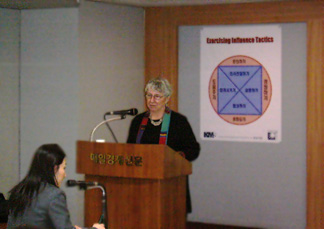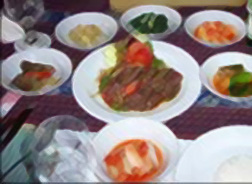Winter/Spring 2005
 Debate
and Discourse in the Year 2005
Debate
and Discourse in the Year 2005
Picture this: an alien anthropologist lands on planet Earth in 2005. The alien makes a point of observing much of what passes for debate in the media, in academia, and in meeting and conference rooms of organizations. The alien might very well conclude that humans engage regularly in the sport of taking turns destroying one another’s ideas. To an alien who had never engaged in this peculiar “sport,” the rules of engagement and scoring system would hardly be obvious.
Although there is a certain satisfaction to be derived from slaying the opposition, most of us would take greater pleasure in participating in what I call “constructive debate.” Constructive debate, ideally, is discourse that results in a robust set of ideas, a challenge to common wisdom, innovative decisions, mutual respect, and learning. At Barnes & Conti, we regularly read reports from highly credentialed national commissions that—in discussing discourse—recommend avoiding “groupthink” and, more recently, assigning a “devil’s advocate” to ensure that ideas do not go unchallenged. Why, then, are so many “debates” characterized either by personal attack and ad hominem argument or, conversely, by public passivity and private cynicism?
I suspect that all these negative characteristics are true—at least partly—because most of us have had very few opportunities to experience a truly constructive debate. The models we are exposed to are not generally ones we wish to emulate. Fear of conflict or retribution can silence dissent. Ideas are often passed along without being exposed to critical thinking—and some of them are bad ideas. Innovation is stifled when disagreement is not invited, encouraged, and supported. “Political correctness” becomes the enemy of excellence.
When we were first asked by a client to develop a program on “constructive debate,” I acknowledge that I was cynical enough to consider it a self-canceling concept. I had always thought of debate as the process of contesting ideas so as to prove the other side wrong and one’s own position right. As we began to explore the subject, however, I began to see some possibilities of using debate as a key to successful innovation and productivity. If the goal of a debate were to be a rigorous exploring and challenging of ideas for the purpose of creating stronger proposals and better decisions rather than to score points, then the process could have great value. If instead of assuming an oppositional stance, we could take an objective posture—one that invites and welcomes feedback on ideas—then the process could be used for building rather than destroying ideas.
The process of developing and implementing this new course has proved to be both challenging and enlightening. We participated in many constructive debates ourselves in the process of program development. We have been encouraged to learn that participants have been applying the skills themselves and, as leaders, are developing the environments in which constructive debates can take place. Homo sapiens—that is, the wise species that we want our hypothetical alien to observe—can and will practice enlightened give-and-take when given the example, the setting, and the opportunity.
—Kim
*Constructive Debate: Building Better Ideas™ is one of our newest programs. Click here for the program description.
In this Issue:
- “Dealing With Unconstructive Debate Behaviors,” B. Kim Barnes
- What’s New at Barnes & Conti?
- Exercising Influence in the Republic of Korea
- Exercising Influence book published in Polish
- Showcasing Constructive Debate
- New on Our Website
- In the Media
- Events, Trade Shows, and Happenings
- Public Programs
- Featured Recipe: Bulgogi (Korean Marinated Beef)
- Just for Fun: Dachshund on Safari
- Featured Art (web version only) “Yellow-Red-Blue” by Wassily Kandinsky
Dealing With Unconstructive Debate Behaviors
B. Kim Barnes
Some of what passes for debate in today’s polarized media sounds rather more like a screaming match or playground name-calling contest. Unfortunately, as more and more people are exposed to this style of (non) communication, some of it has filtered into corporate meeting rooms and teleconferences. You may one day find yourself facing such a situation, and it is best to be prepared. Here are some guidelines to keep in mind:
- Keep your cool. Never allow an ad hominem argument or accusation
to push your defensiveness buttons, or you may find yourself the focus
of a feeding frenzy.
Example: “What is the concern behind that question?” - Stay rational. Your adversary would prefer to fight the issue on an emotional
or polarized basis. Your best offense is to remain perfectly reasonable.
Example: “That’s an interesting point of view…how did you arrive at that conclusion?” - Ask the other person to clarify his or her position or rationale. Do
this calmly but persistently until you think you understand it (even though
you don’t
agree).
Example: “What is the basis for that position? Explain your rationale to me.” - Recognize a “trap question” and
rephrase it as that person’s opinion rather than answering it.
Example: “I gather from your question that you disagree with me about…” - Don’t
allow yourself to be interrupted before finishing a thought; insist on
your airtime.
Example: “Stop! I’d like to finish my thought, then I’d be interested in hearing your response.” - When you paraphrase the
other person’s point, do it in a way that makes the statement sound
more reasonable or intelligent than you actually think it is rather than
going down the tempting but dangerous path of making that person sound
bad, wrong, or stupid.
Example: “So, from your point of view, you would…do I have that right?” - Don’t
allow an inaccurate characterization of your views to stand. Stop the process,
if necessary, and correct the person publicly but politely by restating
your opinion or idea.
Example: “No, that is not an accurate reflection of my opinion. I said…” - Look for an opportunity to consider a
point the other person is making in a constructive and rational way, even
if you still disagree with it.
Example: “Before you continue, let me make sure I have understood your point. You think…” - Use a presumptive
question to learn the strength of the other’s opinion.
Example: “Are you saying that there are NO circumstances under which you would consider…?” - If the other person does not give you any airtime, interrupt when she
or he pauses for breath, but only to paraphrase, in a non-evaluative way,
a point the person has made (not to insert your thoughts). Pause for a
split-second, then say why you disagree.
Example: “You’ve made an interesting point about...(pause). Here’s where I disagree…”
What's New at Barnes & Conti?
 Exercising
Influence in the Republic of Korea
Exercising
Influence in the Republic of Korea
Barnes & Conti’s CEO and resident globetrotter, Kim Barnes, just returned from a trip to the Far East, which was highlighted by a showcase presentation sponsored by KMS (Korea Management Solutions), our new partner company. The event in Seoul, during which Kim co-presented with Dr. Johnny Chung, featured our globally popular Exercising Influence® program. Jenny Jang, the President of KMS, and members of her staff were gracious hosts during Kim’s visit.
Pictured here is Kim in action. The Exercising Influence Tactical Model that you can see behind Kim is, of course, in Korean!
Dr. Chung, Senior Consultant and Facilitator for KMS, has translated the Exercising Influence program into Korean and has recently completed the translating of Kim’s book. If your company has a location in Korea, please let us know and we will put you in touch with KMS.
Exercising Influence book in Polish
Kim Barnes’ book, Exercising Influence: A Guide for Making Things Happen at Work, at Home, and in Your Community, was recently published in Polish! We understand from our partners in Poland, the Polsko-Amerykanski Instytut Zarzadzania (Polish-American Institute), that it is selling well. The need to influence in all aspects of life seems to be universal.
Showcasing Constructive Debate
In early March, Barnes & Conti hosted a showcase luncheon during which Kim Barnes and Rebecca Hendricks (one of our senior associates) presented highlights from our program, Constructive Debate: Building Better Ideas™. The attendees—most of whom were recognized “thought leaders” for prominent Bay Area companies—generally agreed that the showcase was a very dynamic experience. Participants left with some solid tools and ideas for fostering constructive debate within their organizations.
We are planning to host another Constructive Debate showcase in the South Bay (San Francisco Bay Area) in the near future. If you are interested in attending, please send us an e-mail.
New on Our Web Site
- Barnes & Conti in the Community: (Ed. Note: link removed, dated material)Read about our new collaboration with Youth Together, an East Bay Group that reaches out to high school students. We'll be developing a leadership curriculum for the students. We also have information about some worthy organizations that move ideas into action, in our community and around the globe.
- For the Press: Our recent press releases are now available online, beginning with summer 2004.
Please visit our What’s New page; it is regularly updated and contains many late-breaking stories that don’t make it into our newsletter.
In the Media: Leadership Excellence
The magazine, Leadership Excellence—formerly called Executive Excellence—is featuring an article by Kim Barnes in the March issue. The article is entitled “Active Influence: Win Support for Your Ideas.” For non-subscribers, watch for this article in our upcoming “Focus on Influence” newsletter in late spring/early summer.
Also look for an article by Kim Barnes and Jack Harris MD, Vice President of Global Medical Operations at Lilly Research Laboratories, in April's issue of Leadership Excellence. The article is entitled “Leadership Storytelling: Learn How to Get People to Connect with You.”
Events, Trade Shows, and Happenings
Best in the West: Bay Area Organization Development
Network
April 29-30, 2005, San Francisco, CA
Seminar featuring Kim Barnes and Rebecca Hendricks:
“Getting to Maybe: The Rocky Road to Constructive Debate; a Success Story”
Saturday, April 30, 10:00 - 11:30 AM
The Society of Pharmaceutical and Biotech Trainers
(SPBT):
Annual Conference
May 9-12, 2005, Boston, MA
Information/Registration
for SPBT
ASTD 2005 International Conference & Exposition
June 5-9,
2005, Orlando, FL
Information/Registration
for ASTD
Seminar featuring Kim Barnes and Jack Harris MD, Vice President of Global Medical Operations, Lilly Research Laboratories
“Inspirational Leadership: Involving Senior Leaders in Developing the Next Generation”
Wednesday, June 8, 2005 8:00 - 9:15 AM followed by book signing with Kim Barnes
Upcoming Public Programs
Exercising Influence
April 27-28, San Francisco, CA
June 14-15, Milpitas, CA
Constructive Debate
May 5-6, Berkeley, CA
July 18-19, Berkeley, CA
Strategic Thinking
June 3, Berkeley, CA
Building Working Relationships
July 12-13, Milpitas, CA
Stone Soup Leadership
April 18-19, Berkeley, CA
From Conflict to Consensus
May 17, Berkeley, CA
Intelligent Risk-Taking
May 13, Berkeley, CA
Constructive Negotiation
May 12, Berkeley, CA
To
register for one of our public programs, click here
or go to: www.barnesconti.com/ppsched.php
 Featured Recipe: Bulgogi (Korean Marinated
Beef)
Featured Recipe: Bulgogi (Korean Marinated
Beef)
Bulgogi, marinated, pan-grilled beef, is one of the most popular Korean dishes among westerners. The version below uses ingredients that are easy to find in most large supermarkets. If you want to dine Korean style, serve the Bulgogi with steamed rice, kimchi, and other side dishes (see recipes, below).
Kimchi is, of course, the Korean national dish of spicy, pickled cabbage (there are many other types of kimchi as well.) Kimchi is generally available at supermarkets on the West Coast. If your grocery store doesn't carry it, you should be able to find some at an Asian market. Refrigerated, it will keep for several months.
Ingredients:
- 1 1/2 lbs. boneless beef ribeye (or other lean, tender cut of beef)
- Optional: chopped scallions and toasted sesame seeds for garnish
- Sesame oil (the red, flavorful type)
Marinade:
- 6 tbsp soy sauce (tamari works best)
- 2 tbsp rice vinegar
- 2 tbsp rice wine, sherry, or sweet white wine
- 2 tbsp brown sugar
- 2-3 cloves garlic, pressed
- 2-3 tsp grated ginger (or more, to taste)
Method:
- Mix together all the ingredients for the marinade.
- Slice the beef as thinly as possible against the grain.
- Place the beef in a non metallic, shallow dish, cover pour in the marinade, and mix to coat the beef well.
- Marinate for at least 2-3 hours, or—better—refrigerate and marinate overnight. You may want to turn the beef slices in the marinade from time to time.
- Just before serving, lightly coat a grill or skillet (cast iron is best) with oil and heat until the skillet is very hot, but the oil is not smoking.
- Add the beef, but reserve the leftover marinade.
- Stir-fry the beef over high heat for 2-4 minutes (depends on the thickness of the beef slices), until it is just about cooked to your liking.
- Optional: add the reserved marinade and let it bubble away for a minute or two.
- Drizzle the meat generously with sesame oil, remove to a serving dish, and garnish with toasted sesame seeds and/or chopped scallions.
Serves 4.
Korean Side Dishes (Namool)
These small side dishes are traditionally served from the center of the table; everybody takes from them with their chopsticks. If you like them as much as we do, you may double the recipes! All the recipes would serve four people in traditional Korean fashion.
Just for Fun
 Dachshund on Safari
Dachshund on Safari
A wealthy man decides to go on a safari in Africa. He takes his faithful pet dachshund along for company. One day, the dachshund starts chasing butterflies and before long the dachshund discovers that he is lost.
So, wandering about, he notices a leopard heading rapidly in his direction with the obvious intention of having lunch. The dachshund thinks, “OK, I’m in deep trouble now!” Then he notices some bones on the ground close by, and immediately settles down to chew on the bones with his back to the approaching cat.
Just as the leopard is about to leap, the dachshund exclaims loudly, “Boy, that was one delicious leopard. I wonder if there are any more around here?”
Hearing this, the leopard halts his attack in mid-stride, as a look of terror comes over him, and slinks away into the trees. “Whew,” says the leopard. “That was close. That dachshund nearly had me.”
Meanwhile, a monkey who had been watching the whole scene from a nearby tree figures he can put this knowledge to good use and trade it for protection from the leopard. So, off he goes. But the dachshund sees him heading after the leopard with great speed, and figures that something must be up.
The monkey soon catches up with the leopard, spills the beans and strikes a deal for himself with the leopard. The leopard is furious at being made a fool of and says, “Here monkey, hop on my back and see what’s going to happen to that conniving canine.”
Now the dachshund sees the leopard coming with the monkey on his back, and thinks, “What am I going to do now?" But instead of running, the dog sits down with his back to his attackers, pretending he hasn’t seen them yet... and just when they get close enough to hear, the dachshund says...
“Where’s that damn monkey? I sent him off half an hour ago to bring me another leopard.”
Please send feedback to newsltr1
at barnesconti.com
Barnes & Conti, 940 Dwight Way Suite 15, Berkeley, CA 94710, USA
Copyright © 2006 Barnes & Conti Associates, Inc. ALL RIGHTS
RESERVED.
